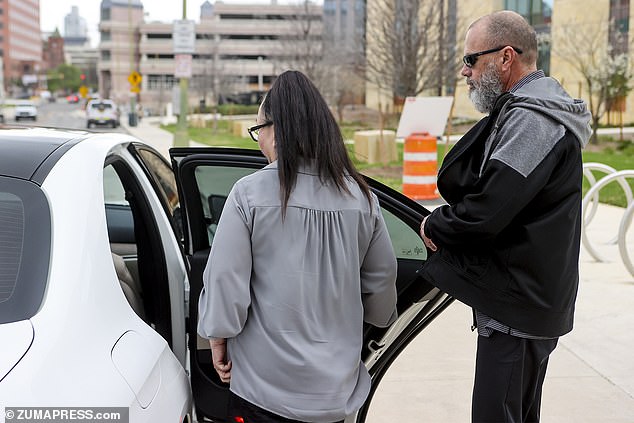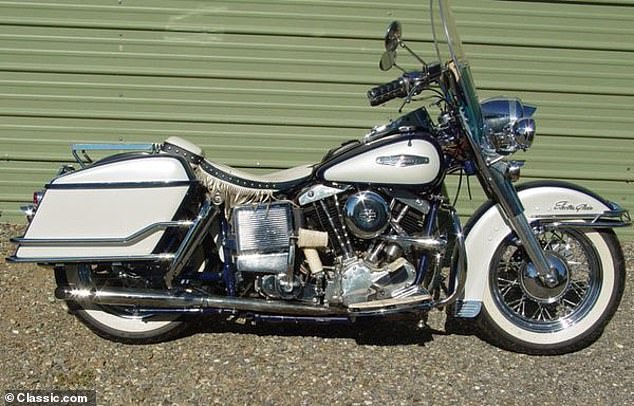Loot seized from ‘Gucci goddess’ Janet Mello is under attack from pests at a Texas warehouse as prosecutors try to recover $108 million lost to the Army fraudster.
The former treasury officer faces up to 125 years in prison after she admitted to using funds intended for soldiers’ children on a large fleet of luxury cars and 31 houses across the United States.
Many are believed to have already been sold by the federal government, but a receiver has been appointed to sell the rest before they rot in storage.
“A lot of these things, especially the vehicles, haven’t moved in months, if not years,” U.S. District Attorney Todd Keagle told the court.
“Rodents and rust appear to have damaged some of the items, which are also suffering from lack of use. ‘That is why it is important that the goods are sold before their value falls further.’

Mello, 57, stole millions of dollars from military funds and blew it on jewelry, clothing, luxury vehicles and real estate in one of the biggest frauds the military has ever seen.


Janet Yamanaka Mello was seen leaving the federal courthouse in San Antonio with her husband Mark after she appeared before Magistrate Judge Richard Farrer and pleaded guilty to five counts of mail fraud and five counts of filing fraudulent tax returns


A 1911 Harley-Davidson 7 is among the choices in Mello’s classic motorcycle collection (file photo)
Mello was in San Antonio court Wednesday with her husband Mark to plead guilty to five counts of mail fraud and five counts of filing fraudulent tax returns.
She controlled the finances of the 4-H Military Partnership Grant program and was able to divert $108 million to a sham company she created over an eight-year period.
She accumulated nearly 80 luxury vehicles Maseratis, Ferraris, Aston Martins, Mercedes, Teslas, Land Rovers and more than a dozen Harley-Davidson motorcycles, some dating back to 1911.
Delivery men called her the ‘Gucci Goddess’ for the constant flow of jewels and luxury clothes ordered to her addresses in Texas, Maryland, Colorado, Washington and New Mexico.
The loot, which was brought to a federal lockup in Gonzales County, includes four classic cars, two John Deere tractors and 11 of her motorcycles.
The 1911 Harley-Davidson is described as a 7 Single, while other models included a 1927 Indian Scout, a 1926 Harley B-Single and a 1956 Ariel.
Jewelry, a boat, a gun safe and six all-terrain vehicles also await new owners at the depot 80 miles east of San Antonio.
But the newly appointed receiver will also be asked to get what he can for more muddled things like ‘more boxes of crockery’ and ‘two ladders’.


A 1955 Ferrari Fratelli was also seized by investigators (file photo)


Mello also owned a 2003 Aston Martin Vanquish (file photo)




Mello also owned a 1935 Plymouth Sedan (file photo) and a 2018 Maserati Granturism (file photo)


Mello used some of the $100 million she took from the U.S. Army to buy a $250,000 Land Rover Range Rover, federal prosecutors say.


The warehouse in Gonzales County also contains what is listed as ‘Two John Deere Tractors’


The 1968 Harley-Davidson FLH Electra Glide has a top speed of just under 100 mph
“Ultimately, we expect there will be a large number of assets both in number and monetary value that will be recovered by the US government,” Mello’s lawyer Albert Flores said as she left court.
‘Today was the beginning of the long process in which she pleaded guilty.
‘She takes responsibility for her actions. She is very remorseful for what she has done.’
Her plan fell apart as IRS criminal investigators worked with Army investigators as they put the pieces of the puzzle together — before Mello was criminally indicted in December 2023.
It was the IRS that pointed out that her lifestyle — buying million-dollar homes several times a year — was not supported by her $130,000 a year.
Despite the significant criminal fraud she is accused of, she was allowed to leave without bail, and officials sparked outrage after it emerged Mello is set to be allowed to retire with full benefits.
The military admitted there was nothing they could do to remove it from her because she was protected under a federal law that was held up in the government bureaucracy.
An army spokesman said: “The command has no authority to affect Ms Mello’s retirement.”
While there are exceptions for treason and major offenses, “there is no similar statutory authority to deny retired pay based on a conviction for other offenses,” she added.
After the scheme came to light, questions were raised as to how the military could not see such a large sum of money being moved under their noses.
Assistant U.S. Attorney Justin Simmons said the Army had not conducted proper audits of her program, while others close to the investigation say the Army was just operating on an assumption of goodwill on the part of its employees.
A source familiar with the investigation told the Express-News of Army leaders: ‘They sent the process to only one person.
“They gave her complete carte blanche and she found all the loopholes.”


One of the sprawling mansions that drew attention to Mello was this eight-bedroom, sixteen-bathroom home in Preston, Maryland—when the IRS began to question how she could afford such lavish purchases on a $130,000 salary


This is Mello’s $2.3 million estate in Castle Rock, Colorado


This home was listed as one of the properties to be seized. It cost Mello $1.1 million and is in San Antonio, Texas


Mello’s $3.1 million estate in Preston, Maryland. She regularly filed fraudulent paperwork and deposited grants a total of 40 times in her fake business over a six-year period, securing more than $100,000,000 for herself, court documents allege.
The army had also replaced some of its administrative restrictions as part of an ‘organisational shake-up’, giving Mello autonomy in her position.
An insider told the local paper: ‘It speaks to the command’s nonchalance and its lack of internal controls.’
Former federal prosecutor Robert Almonte Jr. said Mello wasn’t even “discreet on her part” and her plot was “nothing super complex,” but incompetent government programs aren’t “equipped to monitor these things.”
Almonte continued: “In some cases of fraud, they at least take steps to cover up their fraud. There was no apparent attempt to hide what she did with the money afterwards.’
